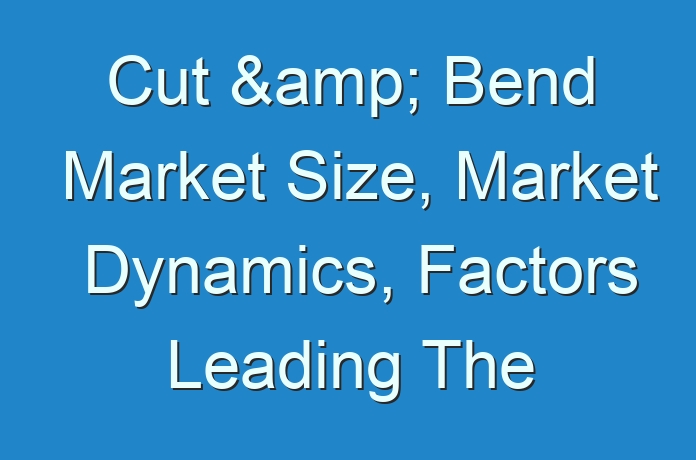
Cut and bend is the value added solution for fabrication and optimization of rebar in the factory environment. The rebars are cut and bent in specific shapes depending on the structural design. These rebars are available in various sizes and shapes and are prepared in factories offsite. The cut and bend are prepared from specialized machinery which ensures high precision and zero wastage in the form of scrap. In various developed countries, the working of rebar is strictly done offsite as regulated by law; therefore, offsite fabrication is majorly preferred by manufacturers, since onsite fabrication is considered unsafe. This is further expected to boost the growth of the cut and bend market over the forecast period.
The working of rebar at construction sites results in significant logistic inefficiencies such as additional site costs, double handling, material wastage, and unsafe and inaccurate cuts and bends. These factors encourage manufacturers to opt for offsite production of cut and bend products, hence driving the market growth over the forecast period. Other factors influencing the market growth for cut and bend products include less labor hassles, better time management, and improved quality.
Additionally, cut and bend rebar products help in managing the inventory better which not only reduces the space requirement for keeping the rebars but also assists in saving costs associated with labor and wastage. Moreover, easy procurement, no misplacement of materials, lower working capital in maintaining the inventory, and the freedom of designing complex pillars, columns, and ceilings encourages manufacturers to utilize cut and bend products, thus boosting the cut and bend market growth in the coming years. However, in developing countries such as the Philippines, construction sites still perform rebar work such as cutting and bending on the site itself, which is projected to hamper the cut and bend market growth over the forecast period.
Purchase our premium research report at:https://www.transparencymarketresearch.com/checkout.php?rep_id=63426<ype=S
Cut and bend products also help in overcoming several challenges such as timely availability of material, shortage of skilled labor, scrap disposable, high precision, and exact shape during onsite cutting and bending process of rebars. These factors are expected to drive the market growth over the forecast period. The cutting and bending process offsite also ensures hassle free construction and provides high quality steel, thus boosting the demand and market growth of cut and bend products.
The global cut and bend market can be segmented based on product type, operational mode, end-user industry, and region. Based on product type, the cut and bend market for cut and bend is segregated into mesh cutting & bending, stirrups, cutting & shaping, bars shaping, straightening, and others (cage, shears, etc.). The operational mode is categorized into manual and automatic mode.
End-user industry in the cut and bend market include construction industry, manufacturing industry, wire/mattress, steel industry and other industry such as welding line, oil & gas, etc. Construction end-user segment is projected to contribute majorly to the market growth in terms of revenue over the forecast period. The growth is attributed to the various benefits associated with the products such as zero wastage on cuts, elimination of double handling, safer construction site, consistent and precise cuts and bending, and zero damage caused to the bars during the cut and bending process. Based on region, the cut and bend market can be segmented into North America, Europe, Asia Pacific, Middle East & Africa, and South America.
The report offers a comprehensive evaluation of the market. It does so via in-depth qualitative insights, historical data, and verifiable projections about market size. The projections featured in the report have been derived using proven research methodologies and assumptions. By doing so, the research report serves as a repository of analysis and information for every facet of the market, including but not limited to: Regional markets, technology, types, and applications.
The study is a source of reliable data on:
- Market segments and sub-segments
- Market trends and dynamics
- Supply and demand
- Market size
- Current trends/opportunities/challenges
- Competitive landscape
- Technological breakthroughs
- Value chain and stakeholder analysis
The report has been compiled through extensive primary research (through interviews, surveys, and observations of seasoned analysts) and secondary research (which entails reputable paid sources, trade journals, and industry body databases). The report also features a complete qualitative and quantitative assessment by analyzing data gathered from industry analysts and market participants across key points in the industry’s value chain.
A separate analysis of prevailing trends in the parent market, macro- and micro-economic indicators, and regulations and mandates is included under the purview of the study. By doing so, the report projects the attractiveness of each major segment over the forecast period.
Highlights of the report:
- A complete backdrop analysis, which includes an assessment of the parent market
- Important changes in market dynamics
- Market segmentation up to the second or third level
- Historical, current, and projected size of the market from the standpoint of both value and volume
- Reporting and evaluation of recent industry developments
- Market shares and strategies of key players
- Emerging niche segments and regional markets
- An objective assessment of the trajectory of the market
- Recommendations to companies for strengthening their foothold in the market
Note: Although care has been taken to maintain the highest levels of accuracy in TMR’s reports, recent market/vendor-specific changes may take time to reflect in the analysis.
TMR is a leader in the market research space providing end-to-end business solutions and consulting services. TMR operates from its own office space of almost 10,000 sq. ft located in a prime commercial complex at Pune. We serve clients in 150 countries with an approach to deep dive into the economic aspects and geographical nuances for unfailing business intelligence.
Contact us:
Transparency Market Research
State Tower,
90 State Street, Suite 700,
Albany NY – 12207,
United States
Tel: +1-518-618-1030 Email: sales@transparencymarketresearch.com
Website: https://www.transparencymarketresearch.com





